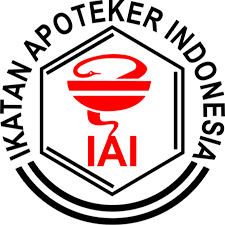In Silico Molecular Docking and Toxicity Studies of Bioactive Fucoidan Compound from Brown Seaweed as Potential of Antihypertensive
Agus Kurniawan(1*), Siswandono Siswandono(2), Esti Mumpuni(3), Syamsudin Abdillah(4)(1) Universitas Gunadarma
(2) Universitas Airlangga
(3) Universitas Pancasila
(4) Universitas Pancasila
(*) Corresponding Author
Abstract
Angiotensin Converting Enzyme (ACE) is an enzyme that can convert angiotensin 1 to angiotensin 2 peptide, which is a strong vasoconstrictor that causes hypertension. Fucoidan (4,5-dihydroxy-2,6-dimethyltetrahydro-2H-pyran-3-yl hydrogen sulfate) is one of the polysaccharide chemical compounds found in seaweed and is reported to have the ability to inhibit ACE activuty in vitro. The aim of this study is to predict of the binding interaction between fucoidan and amino acids in ACE and to use the native captopril ligand (MCO702) as the standard ligand. Analysis of the molecular docking of fucoidan and captopril compounds against ACE (1UZF) using Molegro 6.0 and Chemoffice Professional 17.1 Software and for toxicity analysis using pkCMS online tools. The results of the docking prediction showed that fucoidan had MolDock and Rerank Score values of -82.311 kcal/mol and -70.872 kcal/mol, respectively, which were not much different from captopril, namely -84.816 kcal/mol and -74.758 kcal/mol. Fucoidan and captopril are also easily absorbed and have good permeability and are classified as low toxicity, but are dangerous if ingested in the 2000 <LD50≤ 5000 mg/kg range. Fucoidan has the potential as a candidate for antihypertensive drugs because it is predicted that in silico has the same ability as captopril.
Keywords
Full Text:
PDFReferences
Battegay, E.J., Lip, G.Y.H., Bakris, G.L., 2005. Hypertension Principles and Practice. Taylor & Francis Group, New York, USA.
Carey, R.M., 2007. Hypertension and Hormone Mechanisms. Humana Press, New Jersey, USA.
Copeland, R.A., 2005. Evaluation of Enzyme Inhibitors in Drug Discovery : A Guide for Medicinal Chemists and Pharmacologists. John Wiley & Sons, Inc., New Jersey, USA.
Cui, W., Zheng, Y., Zhang, Q., Wang, J., Wang, L., Yang, W., Guo, C., Gao, W., Wang, X., Luo, D., 2014. Low-molecular-weight fucoidan protects endothelial function and ameliorates basal hypertension in diabetic
Goto-Kakizaki rats. Lab. Investig. 94, 382–393.
C
ushman, D.W., Ondetti, M.A., 1991. History of the design of captopril and related inhibitors of angiotensin converting enzyme. Hypertension 17, 589–592.
Fagyas, M., Uri, K., Siket, I.M., Darago, A., Boczan, J., Banyai, E., Edes, I., Papp, Z., Toth, A., 2014. New perspectives in the renin-angiotensin-aldosterone system (RAAS) III: Endogenous inhibition of angiotensin converting enzyme (ACE) provides protection against cardiovascular diseases. PLoS One 9, 1–13.
http://biosig.unimelb.edu.au/pkcsm/prediction.
https://cactus.nci.nih.gov/translate/.
https://www.rcsb.org/.
Huang, S.Y., Zou, X., 2010. Advances and challenges in Protein-ligand docking. Int. J. Mol. Sci. 11, 3016–3034.
Kemenkes RI, 2018. Riset Kesehatan Dasar 2018. Jakarta.
Kemenkes RI, 2013. Riset Kesehatan Dasar 2013. Jakarta.
Li, B., Lu, F., Wei, X., Zhao, R., 2008. Fucoidan: Structure and bioactivity. Molecules 13, 1671–1695.
Lipinski, C.A., Lombardo, F., Dominy, B.W., Feeney, P.J., 2001. Experimental and computational approaches to estimate solubility and permeability in drug discovery and development settings. Adv. Drug Deliv. Rev. 46, 3–26.
Maneesh, A., Chakraborty, K., Makkar, F., 2017. Pharmacological activities of brown seaweed Sargassum wightii (Family Sargassaceae) using different in vitro models. Int. J. Food Prop. 20, 931–945.
Miller, E.M., Cziraky, M., Sarah, A., 2006. ACE inhibitors versus ARBs: comparison of practice guidelines and treatment selection considerations. Formulary 41, 274–284.
Molegro, 2013. Molegro virtual docker: User manual. CLC bio, Denmark.
Nagappan, H., Pee, P.P., Kee, S.H.Y., Ow, J.T., Yan, S.W., Chew, L.Y., Kong, K.W., 2017. Malaysian brown seaweeds Sargassum siliquosum and Sargassum polycystum: Low density lipoprotein (LDL) oxidation, angiotensin converting enzyme (ACE), α-amylase, and α-glucosidase inhibition activities. Food Res. Int. 99, 950–958.
Nations United, 2013. Globally Harmonized System of Classification and Labelling of Chemicals (GHS), 5th ed. New York and Geneva.
Neal, B., MacMahon, S., Chapman, N., 2000. Effects of ACE Inhibitors,Calcium Antagonists, and Other Blood Pressure Lowering Drugs : Results Of Perspectively Designed Overview Of Randomised Trials. Lancet 356, 1955–1964.
Park, B.G., Kwon, S.C., Park, G.M., Ham, J., Shin, W.S., Lee, S., 2008. Vasodilatation effect of farnesylacetones, active constituents of Sargassum siliquastrum, on the basilar and carotid arteries of rabbits. Bioorganic Med. Chem. Lett. 18, 6324–6326.
Park, B.G., Shin, W.S., Oh, S., Park, G.M., Kim, N.I., Lee, S., 2017. A novel antihypertension agent, sargachromenol D from marine brown algae, Sargassum siliquastrum, exerts dual action as an L-type Ca2+ channel blocker and endothelin A/B2 receptor antagonist. Bioorganic Med. Chem. 25, 4649–4655.
Raji, V., Loganathan, C., Sadhasivam, G., Kandasamy, S., Poomani, K., Thayumanavan, P., 2020. Purification of fucoxanthin from Sargassum wightii Greville and understanding the inhibition of angiotensin 1-converting enzyme: An in vitro and in silico studies. Int. J. Biol. Macromol. 148, 696–703.
Sharifi, N., Souri, E., Ziai, S.A., Amin, G., Amanlou, M., 2013. Discovery of new angiotensin converting enzyme ( ACE ) inhibitors from medicinal plants to treat hypertension using an in vitro assay. DARU J. Pharm. Sci. 21, 1–8.
Shin, W.S., Oh, S., An, S.W., Park, G.M., Kwon, D., Ham, J., Lee, S., Park, B.G., 2013. 5E- and 5Z-farnesylacetones from Sargassum siliquastrum as novel selective L-type calcium channel blockers. Vascul. Pharmacol. 58, 299–306.
Sousa, S.F., Fernandes, P.A., Ramos, M.J., 2006. Review: Protein–Ligand Docking: Current Status and Future Challenges. PROTEINS Struct. Funct. Bioinforma. 6515–26 65, 15–26.
Trott, O., Olson, A.J., 2009. AutoDock Vina: improving the speed and accuracy of docking with a new scoring function, efficient optimization and multithreading. Journal of Computational Chemistry. J. Comput. Chem. 31, 455–461.
Article Metrics
Abstract view(s): 1771 time(s)PDF: 3900 time(s)









